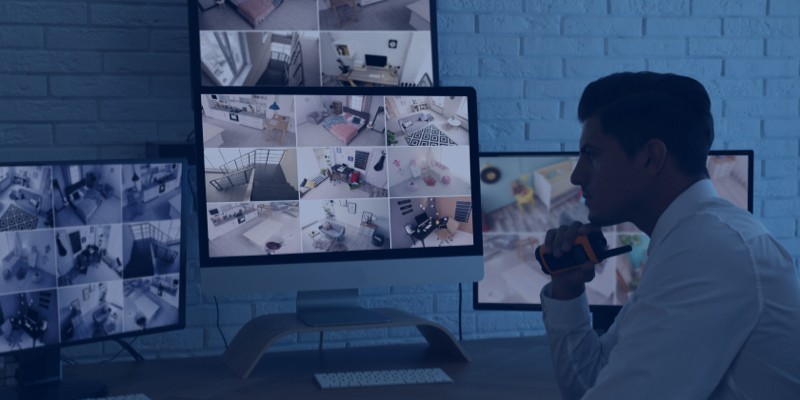Introduction:
In a time of rapid technological advancement and changing security challenges, remote video monitoring has become vital for protecting businesses, properties, and public spaces. The ability to monitor location remotely, in real-time, has transformed how we approach security. In this post, we’ll delve into why remote video monitoring matters, exploring its pivotal role in enhancing security, improving cost-effectiveness, and ensuring peace of mind for stakeholders.
Enhancing Security
Remote video monitoring systems serve as vigilant guardians, providing continuous surveillance and proactive threat detection capabilities. By deploying strategically positioned cameras and leveraging advanced monitoring technology, businesses can deter criminal activities and respond swiftly to security incidents. The mere presence of surveillance cameras acts as a powerful deterrent, dissuading potential intruders and vandals from targeting the premises. Moreover, real-time monitoring allows security personnel to promptly identify and address security breaches, minimizing the risk of property damage, theft, or unauthorized access.
Cost-Effectiveness
In addition to bolstering security, remote video monitoring offers significant cost savings compared to traditional security measures. Implementing on-site security personnel can be financially burdensome, especially for businesses operating on tight budgets. Remote video monitoring systems eliminate the need for round-the-clock physical presence, reducing labour costs while providing comprehensive surveillance coverage. Furthermore, the long-term benefits of remote monitoring extend beyond monetary savings, encompassing improved operational efficiency and reduced losses due to theft or property damage.
Remote Accessibility
One of the critical advantages of remote video monitoring is its unparalleled accessibility. With the ability to monitor premises from anywhere, at any time, stakeholders can maintain constant oversight and control over their assets. Whether checking in on a business after hours or monitoring a vacation home from afar, remote access empowers users to stay informed and responsive to security incidents. The convenience of accessing live video feeds and archived footage via internet-connected devices ensures peace of mind, even when physically distant from the monitored location.
Applications Across Industries
Remote video monitoring finds widespread applications across various industries, from retail and hospitality to manufacturing and transportation. Surveillance cameras help prevent theft, reduce shrinkage, and enhance customer safety in retail environments. In residential properties, homeowners can remotely monitor their homes and loved ones, ensuring security and peace of mind. Industrial facilities utilize remote monitoring to oversee manufacturing processes, ensure workplace safety, and comply with regulatory requirements. Furthermore, public spaces benefit from surveillance cameras, enhancing public safety and deterring criminal activities.
Compliance and Liability
Remote video monitoring systems are crucial in maintaining compliance with industry regulations and mitigating liability risks. By capturing and storing video footage, businesses can provide evidence in the event of security incidents, accidents, or disputes. Additionally, adhering to privacy regulations and implementing best practices for data security are essential considerations when deploying remote monitoring systems. Businesses can mitigate legal risks and prioritize compliance and accountability with customers and stakeholders by prioritizing compliance and accountability.
Scalability and Future-Proofing
One of the inherent strengths of remote video monitoring systems is their scalability and adaptability to evolving security needs. As businesses grow and security requirements evolve, remote monitoring solutions can be easily scaled to accommodate expanding operations or changing threats. Moreover, technological advancements ensure that remote video monitoring systems remain relevant and effective in the face of emerging security challenges. From high-definition cameras to cloud-based storage and advanced analytics, ongoing innovation ensures that remote monitoring solutions continue to deliver value and security in the future.
Addressing Privacy Concerns
While remote video monitoring offers undeniable benefits, it raises legitimate privacy concerns. Businesses must balance enhancing security and respecting individuals’ privacy rights. Implementing clear policies regarding camera placement, data storage, and access permissions is essential to effectively address privacy concerns. Furthermore, transparent communication with stakeholders and compliance with relevant privacy regulations are paramount to building trust and maintaining ethical surveillance practices.
Real-World Impact
The real-world impact of remote video monitoring must be balanced. Countless businesses, organizations, and individuals have experienced the tangible benefits of enhanced security, cost savings, and peace of mind. From preventing burglaries and theft to ensuring workplace safety and regulatory compliance, remote monitoring systems make a meaningful difference in people’s lives. As technology continues to evolve and security challenges evolve, remote video monitoring will remain a cornerstone of modern security strategies, safeguarding assets and protecting communities.
Conclusion
Remote video monitoring is not just a security measure; it’s a powerful tool for enhancing safety, efficiency, and peace of mind. By leveraging advanced technology and strategic surveillance practices, businesses and organizations can deter threats, minimize risks, and maintain a secure environment for their stakeholders. As we continue to embrace the benefits of remote monitoring, let’s prioritize transparency, accountability, and ethical practices to ensure that security remains synonymous with trust and reliability.
